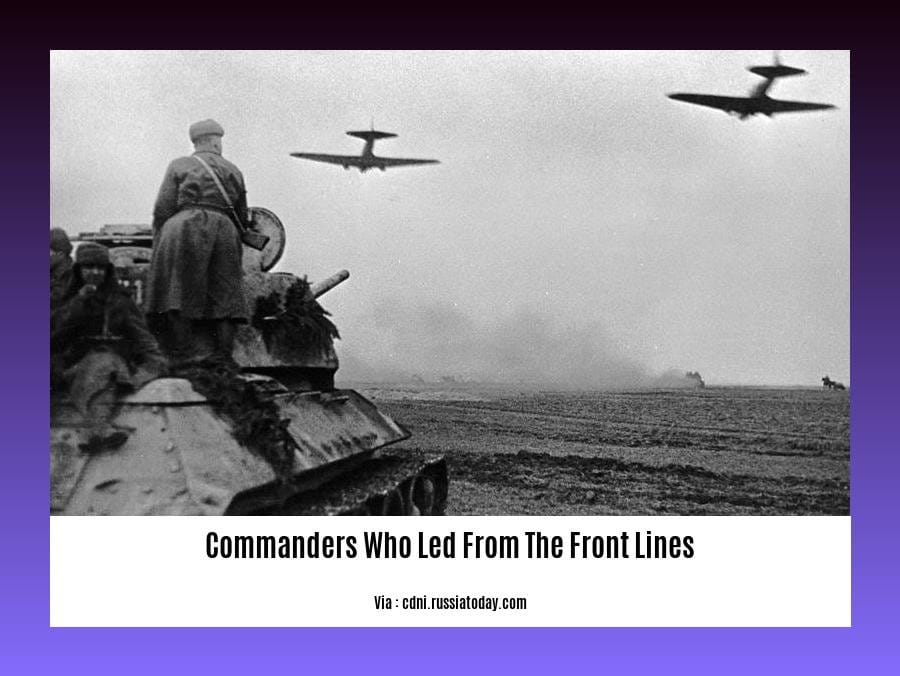Throughout history, warfare has witnessed the emergence of exceptional leaders who inspired their troops by leading from the front lines. From Alexander the Great to George Patton, these commanders personified courage, determination, and the unwavering belief that personal example is the most potent form of leadership. [Commanders Who Led from the Front Lines: A Historical Perspective] explores the profound impact these leaders had on their armies, their campaigns, and the course of history itself.
Key Takeaways:

- Julius Caesar typically led from the rear, but when necessary, he led by example on the front lines.
- Richard I of England consistently led from the front, which proved successful at the Battle of Arsuf.
- As Genghiz Khan, Temujin led from the rear, delegating responsibilities to his subordinates.
Commanders Who Led from the Front Lines
Throughout history, legendary commanders who led from the front lines have inspired their troops and achieved remarkable victories. While some preferred to command from the rear, others willingly stepped into the thick of battle, leading by example. Let’s explore some notable instances of commanding from the front:
Gaius Julius Caesar
Despite preferring to command from the rear, Julius Caesar famously led from the front when faced with crises. During the Battle of Alesia, he personally led a cavalry charge that turned the tide of battle. His willingness to fight alongside his soldiers boosted their morale and proved his courage.
Richard I of England
Richard the Lionheart was renowned for his fierce and courageous leadership. At the Battle of Arsuf, he charged into battle at the head of his army, inspiring them to a decisive victory. His personal involvement in the fight exemplified his unwavering commitment to his troops.
Temujin (Genghis Khan)
By the time Temujin became Genghis Khan, he had transitioned to commanding from the rear. He delegated details to his trusted subordinates, but his strategic brilliance and unwavering determination continued to guide his army to success.
In conclusion, the courage and leadership of commanders who led from the front lines have shaped the course of history. Their willingness to put themselves in harm’s way alongside their troops not only inspired loyalty but also achieved remarkable victories.
Dive into the annals of military history and discover the extraordinary military commanders known for their physical stamina. These unwavering leaders pushed the boundaries of human endurance, inspiring their troops with their indomitable spirit. Learn about their remarkable feats of strength and resilience on ../military-commanders-known-for-their-physical-stamina.
Furthermore, explore the lives of military leaders of incredible endurance and fortitude. These exceptional individuals faced unimaginable challenges with unwavering determination. Their stories of perseverance and courage will captivate you. Read about their remarkable exploits and the lessons we can learn from their indomitable spirit on ../military-leaders-of-incredible-endurance-and-fortitude.
Finally, uncover the secrets of tireless commanders loved by troops. These charismatic leaders forged deep bonds with their soldiers through their unwavering commitment and selflessness. Discover how they motivated their troops to achieve extraordinary victories and earned their enduring admiration on ../tireless-commanders-loved-by-troops.
Impact of Frontline Command on Troops
Throughout history, successful military leaders have understood the importance of embracing the frontline, exemplifying the spirit of their troops and inspiring courage. Here’s how leading from the front can profoundly impact the morale and effectiveness of soldiers:
Morale Boost
When leaders take their place alongside their troops, they demonstrate unwavering commitment and shared risks. This boosts soldiers’ morale, as they see their commanders sharing the same hardships and dangers, fostering a sense of camaraderie and purpose.
Inspiration of Trust
Frontline commanders earn the trust and respect of their soldiers by fighting alongside them. When troops witness their leaders putting themselves in harm’s way, they develop an unyielding belief in their abilities and a willingness to follow them to victory.
Understanding Responsibility
Leaders who command from the front understand the weight of their decisions, as they directly experience the consequences of their actions. This heightened sense of responsibility drives them to make informed choices and prioritize the well-being of their troops.
Clear Communication
In the chaos of battle, clear communication is crucial. Frontline commanders can bypass hierarchical chains of command, ensuring that orders and updates reach the troops swiftly and without distortion.
Finding the Point of Influence
While leading from the front has its advantages, it’s important for commanders to find their optimal point of influence. They must balance the need for personal involvement with the tactical requirement to oversee the battlefield from a broader perspective.
Key Takeaways:
- Frontline command boosts morale and inspires trust among troops.
- Leaders who fight alongside their soldiers demonstrate commitment and shared risks.
- This fosters a sense of camaraderie and shared purpose.
- Commanders who lead from the front gain the trust and respect of their troops.
- They understand the weight of their decisions and prioritize troop well-being.
- Clear communication is crucial in battle, and frontline commanders can bypass communication barriers.
- Commanders should find their optimal point of influence, balancing personal involvement with strategic oversight.
Citation:
- Fast Company: Leading From The Front Lines
Essential Traits of Frontline Commanders
A commander who leads from the front earns respect and loyalty. Their presence in the thick of battle boosts morale, inspires trust, and demonstrates a deep understanding of their responsibility. Frontline leaders walk among their troops, experiencing the same dangers and hardships, which cements their connection and establishes an unbreakable bond.
Key Takeaways:
- Earn Respect and Loyalty: Frontline leaders lead by example, instilling trust and loyalty among their troops.
- Inspire Morale: Their presence on the battlefield elevates morale, boosting the troops’ determination and fighting spirit.
- Demonstrate Responsibility: Commanding from the front embodies the gravity of one’s leadership and the value they place on their troops’ lives.
- Minimize Communication Breakdowns: Being present in the fray allows for direct and timely communication, minimizing the risk of misunderstandings or misinterpretations.
- Avoid the Trap of Sole Frontline Leadership: New leaders should resist the temptation to solely lead from the front. Identifying the point of influence for maximum impact is crucial.
Relevant URL Source:
- Fast Company: Leading From The Front Lines
Legacy and Influence of Frontline Commanders
Leading from the front, commanders play a crucial role in inspiring troop morale and shaping the outcome of battles. Their ability to lead by example and make quick, informed decisions on the ground can significantly influence their legacy and influence in the military and beyond.
Throughout history, several renowned commanders have left an enduring mark on the military and society by leading from the front lines. Their actions and leadership styles continue to serve as case studies for historians and military strategists alike. By understanding the impact of these commanders, we can gain insights into the traits and qualities essential for effective frontline leadership.
Key Takeaways:
- Frontline commanders earn the trust and admiration of their troops by leading by example.
- The ability to inspire loyalty and boost morale is critical for commanders in the field.
- Strong leadership involves balancing responsibility and risk-taking, putting the commander’s life on the line.
- Effective communication is vital in wartime situations, preventing mishaps and ensuring coordination.
- New leaders should find the point of influence where they can maximize their impact rather than solely leading from the front.
Relevant URL Source:
- Fast Company: Leading From The Front Lines

FAQ
Q1: Were there any successful commanders who preferred to lead from the rear?
A1: Yes, Julius Caesar often commanded from the rear but would lead from the front during critical moments.
Q2: Which commander’s leadership style was effective in boosting morale?
A2: Richard I of England’s preference for leading from the front inspired his troops and contributed to their success at the Battle of Arsuf.
Q3: Did all successful commanders lead from the front lines throughout their careers?
A3: No, Temujin, who later became Genghis Khan, transitioned from leading from the front to commanding from the rear and delegating tasks to subordinates.
Q4: What are the potential drawbacks of leading solely from the front lines?
A4: Communication breakdowns can occur due to the lack of situational awareness and coordination. Additionally, commanders may become isolated and vulnerable to enemy attacks.
Q5: How has technology influenced the ability of commanders to lead from afar?
A5: Advanced technologies, such as drones and satellite communication, allow commanders to monitor the battlefield from greater distances, enabling them to make informed decisions while remaining connected to the front lines.
- Senior at What Age: Benefits & Eligibility Guide - March 29, 2025
- Unlocking Senior Benefits: How Old is a Senior? Your Complete Guide - March 29, 2025
- Master Russian Politeness:A Guide to Saying Please - March 29, 2025
















